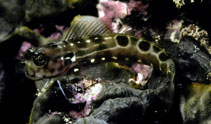| Family: |
Blenniidae (Combtooth blennies), subfamily: Salariinae |
| Max. size: |
4.1 cm SL (male/unsexed) |
| Environment: |
reef-associated; marine; depth range 6 - 8 m |
| Distribution: |
Western Pacific: Palau, Papua New Guinea (Umboi Islands, Trobriand/Kiriwina Islands), and Solomon Islands (Savo, Guadalcanal). |
| Diagnosis: |
Dorsal spines (total): 12-12; Dorsal soft rays (total): 13-14; Anal spines: 2-2; Anal soft rays: 15-16 |
| Biology: |
Adults occur solitary or in small groups in fringing reefs to 8 m deep (Ref. 90102). They inhabit vertical surfaces of cuts along clear reef margins to a depth of 6 m (Ref. 37816). Oviparous. Eggs are demersal and adhesive (Ref. 205), and are attached to the substrate via a filamentous, adhesive pad or pedestal (Ref. 94114). Larvae are planktonic, often found in shallow, coastal waters (Ref. 94114). Minimum depth of 6 m reported from Ref. 1602. |
| IUCN Red List Status: |
Least Concern (LC); Date assessed: 25 March 2009 Ref. (130435)
|
| Threat to humans: |
harmless |
Source and more info: www.fishbase.org. For personal, classroom, and other internal use only. Not for publication.
